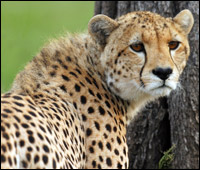Every damn kid in the U.S., son of cabbie or Catholic, knows and cares about dinosaurs. But few have heard of gomphotheres, which lived here much more recently.

Cheetahs never win.
In the late summer, this North American elephant — along with some of its contemporaries, like American camels, cheetahs, lions, and giant tortoises — crept into the minds of many Americans, as the press reported on a proposal put forth by my colleagues and me to bring large animals back to North America.
Our big idea brought an even bigger response from the press, public, and scientific community. It was a wild week of knee-jerking, gasps, and groans — mixed with some joyful salutations and celebratory fists in the air. Much of the press got it wrong; a few got it so right. Many scientists fired off emails and rebuttals; fewer apparently actually sat down and carefully read the paper before firing.
The public took their corners too. This became clear, crystal, as my inbox filled up with hundreds of emails. “What a fantastic idea … how can I help?” many asked. But others were decidedly less supportive. One advised me that, while I was promoting a scientific and careful approach to our proposal, he would be sure “to be really careful when I place the crosshairs on them big goddamn animals and slowly squeeze the trigger of my Remington 300Ultra Mag … P.S.: Are you sane, you f*%$ing moron?” A few of these emails rolled off my back, but after a few hundred, I was watching my back. Thanks to widespread TV, radio, and newspaper coverage, I reckon I had a few new nicknames worse than moron.
The nicknames I can deal with. It’s the history that bothers me.
As North Americans, our elephant experiences should be wild, rather than tented ones brought to us by Barnum and Bailey. In the scope of time, these fine creatures were just with us. Go back about 10,000 years, and the African lion is no longer African; it was found throughout Europe, Asia, and, yes, the good ol’ U.S. of A. When the Egyptian pharaohs were pondering the pyramids 4,000 years ago, a pygmy mammoth still reigned on a small island in the Arctic Ocean. But our ancestors had hunted this continent’s similar creatures to extinction, soon after trudging here for the first time.

Have you herd?
After some reflection in the woods of the Arizona mountains, I realized that it wasn’t that important which corner people took to. Rather, the fact that we got them moving at all may be what counted. Our proposal attempted to use the past to provide a new, optimistic vista for the future of biodiversity. Americans, and humanity in general, continue to erode our environment, becoming more and more removed from a relationship with nature. This is bad for biodiversity, bad for us, and bad for our grandkids. Meanwhile, we just keep hitting the snooze button.
Could large animals — our megafauna — be the thing that finally stirs us? They’re important in our psyche; this is clear from the names of our cars and sports teams. Could Eurasian and African camels, elephants, and lions “replace” those that once roamed the United States? Could they reconnect Americans with nature? Could they return to play long-lost pivotal roles in our ecosystems and economy? A rigorous, cautious scientific approach could help answer these important questions. (Some conservationists are doing just that: The Turner Endangered Species Fund is studying the possibility of reintroducing giant Bolson tortoises, which once thrived across the Southwest, to two ranches in southern New Mexico.)
No one knows the answers, and we all hate uncertainty. Just as scientists are conservative in their findings — generally a good thing — many people are conservative when it comes to environmental issues, likely to turn out to be a very bad thing. Let’s wait and study it more, we say, instead of Let’s study it and act on what we know. Global warming, alternative energy, overfishing — the list goes on and on.
But we need to act. Consider how wilderness has changed since 1905, and how it is likely to change in the next century. We need to decide how much biodiversity and nature we want to coexist with. The deep natural history of our continent provides guideposts for an optimistic roadmap. Following them will require hard decisions, with substantial obstacles and risks. But the risks of the default scenario — a world full of weeds and rats, and the absence of the large animals that capture our imagination — may very well be greater.
Despite the uncertainty, I’m certain those goddamn big animals can help in more ways than one. To that, with my eyes off my back and a fist in the air, I say onward!


